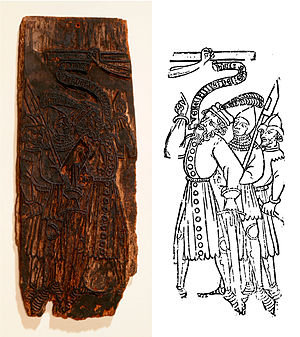
The woodblock fragment Bois Protat ([bwɑ pʁɔta] ("Protat wood[block]"); also Protat block or Protat woodblock, c. 1370–1380) is a fragmentary woodblock for printing, and the images on it are the oldest surviving woodcut images from the Western world. It is cut on both sides, with a scene from Christ's crucifixion on the recto, and a kneeling angel from a presumed Annunciation scene on the verso. The crucifixion scene likely consisted of three or more blocks; the surviving block fragment features Longinus the Roman centurion at the Crucifixion, shown speaking with a banderole, a mediaeval precursor to the modern speech balloon containing his words.
The Bois Protat's name comes from the Mâconnais printer Jules Protat who acquired the block after its discovery in 1898 near La Ferté Abbey in Saône-et-Loire, France, where it was wedged under a stone floor. Because of such poor preservation, only a quarter of the block has survived, and only one side was able to withstand making prints at the time of discovery. It is kept in the Department of Prints and Photographs at the Bibliothèque nationale de France, the National Library of France in Paris.
© MMXXIII Rich X Search. We shall prevail. All rights reserved. Rich X Search
